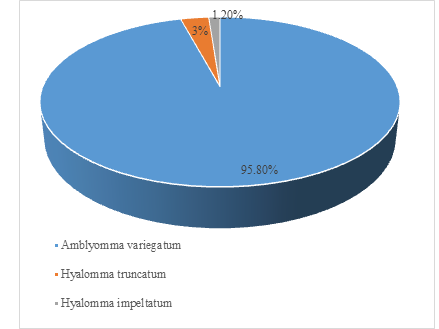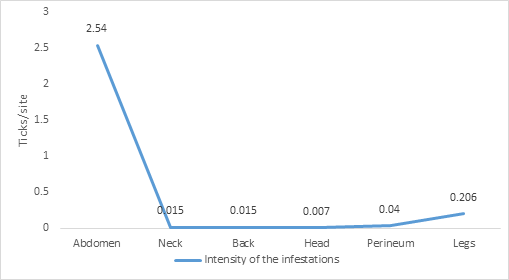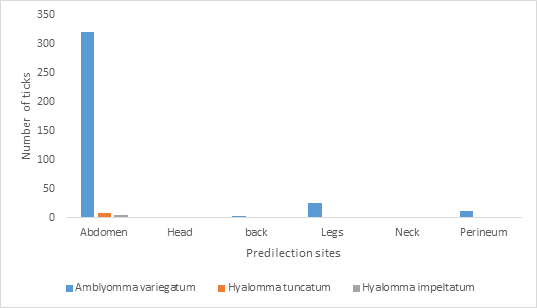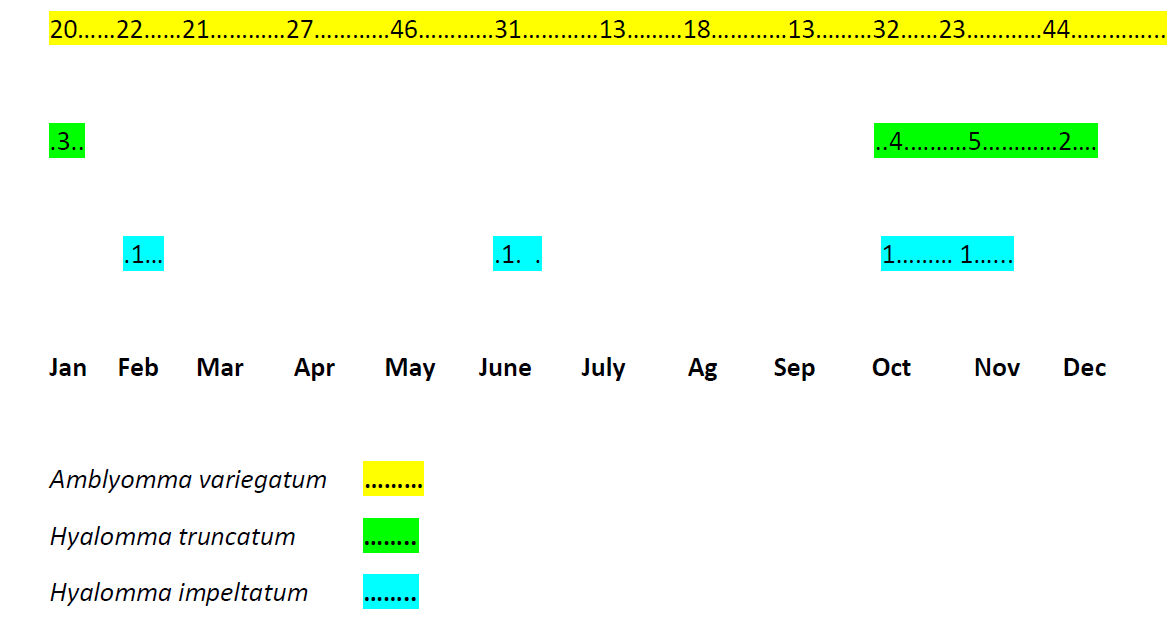Amblyomma Variegatum Hyalomma Truncatum and Hyalomma Impeltatum Anthropophilic Ticks Introduced to Gabon by the Fulbe Zebus from Cameroon: their Predilection Sites and Ability to Live in Gabon
Article Information
Moubamba Mbina Dieudonne1?, Ntountoume Ndong Auguste2, Maganga Gael Darren3,4
1 Laboratoire de zootechnie, Institut de Recherches Agronomiques et Forestières, B.P.2246, Libreville, Gabon
2 Laboratoire d’entomologie et des protections des cultures, Institut de Recherches Agronomiques et Forestières, B.P.2246, Libreville, Gabon
3Centre International de Recherche Médicales de Franceville, B.P. 769, Franceville, Gabon
4Université des Sciences et Techniques de Masuku (USTM), Institut National Supérieur d’Agronomie et de Biotechnologies. B.P. 913 Franceville, Gabon
*Corresponding Author: Moubamba Mbina Dieudonne, IRAF, gros bouquet, BP 2246 Libreville, Gabon
Received: 04 January 2020; Accepted: 11 January 2020; Published: 30 January 2020
Citation: Moubamba Mbina Dieudonne, Ntountoume Ndong Auguste, Maganga Gael Darren. Amblyomma Variegatum Hyalomma Truncatum and Hyalomma Impeltatum Anthropophilic Ticks Introduced to Gabon by the Fulbe Zebus from Cameroon: their Predilection Sites and Ability to Live in Gabon. Archives of Veterinary Science and Medicine 3 (2020): 11-21
View / Download Pdf Share at FacebookAbstract
Cattle imports have introduced anthropophilic ticks from Cameroon to Gabon. A survey was conducted with aims of to determine the relative frequencies of these tick species, to compare the infestation intensities of these arthropods on their fixation sites, on body cattle, to evaluate the duration life of the adults anthropophilic ticks on their hosts throughout the year and to propose an acaricide treatment to apply to zebus before acrossing the frontier. The ticks were collected from their predilection sites, from 131 zebus Fulbe. The abundance of the tick species and their infestation burden were evaluated in relative frequencies and in number of ticks per fixation site respectively. Amblyomma variegatum (95.8%), Hyalomma truncatum (3%) and Hyalomma impeltatum (1.2%) were the three anthropophilic ticks species collected from cattle, the most abundant significantly specie was Amblyomma variegatum (P < 0.05). The abdomen was the highest significantly site infested by all tick species (X²= 123.84, P < 0.05) with an infestation intensity of 2.54 ticks per host; the least significantly infested site was the head (X²= 123.84, P < 0.05) with an infestation burden of 0.007 ticks per host; Amblyomma variegatum was the only tick specie that can support Gabonese climatic conditions; Hyalomma truncatum and Hyalomma impeltatum were xerophilic tick species for which this country is a hostile region because Gabon is a humid forest country. The using of an acaricide to treat cattle before acrossing the border remains the best way to prevent the introduction of ticks to Gabon.
Keywords
Predilection sites ; Anthropophilic ticks; Cattle imports; Gabon; Cameroon
Article Details
1. Introduction
Ticks are hematophagous arthropods that need to attach to their hosts on predilection sites before taking their meals. Before the attachment, factors associated to the host such as, the coat color, life conditions, the odor as well as environmental factor like the seasonal changes influence this attraction [1] [2]. The thickness of the skin, the length of hair as well as the length of the tick mouthparts are other factors [2] implied in tick attachment to the animal; these factors determine the preference of the species of ticks when they attach to the fixation sites; thus the adults of Rhipicephalus appendiculatus infest most of the time ears and the head of cattle; whereas Amblyomma sparsum, a tick attaching usually to the Aldabaran tortoise (Dipsochelys dussumieri) [4] has a tropism for the head, the neck region, the front limbs, the hind limbs and the tail region. In Gabon the Fulbe zebus imported from Cameroon to Gabon have introduced anthropophilic ticks Hyalomma truncatum, Hyalomma impeltatum and Amblyomma variegatum, the two first acarians can transmit a hemorrhagic arbovirus [5] the last specie is a vector of an African rickettsial fever [6] but the fixation sites of these arthropods and their infestation burdern on the body parts of these cattle as well as their ability to adapt to the environment of Gabon are unknown. A study was conducted in order to prevent the introduction of anthropophilic ticks to Gabon, this survey aimed to determine the relative frequencies of the anthropophilic tick species sampled from cattle imports from Cameroon and to compare the infestation intensities of these ticks between the cattle body parts, to evaluate the survival of adult anthropophilic ticks throughout the year on their attachment sites and to propose an acaricide treatment to apply to zebus before acrossing the frontier.
2. Material and Methods
2.1 Location of Owendo municipality
The municipality of Owendo is located in the south of the city of Libreville. The climate in this city is warm and humid. The annual average of the precipitations is 2503mm and for the temperature 26°C. The relative hygrometry in this area is 85%. It is in this city that the abattoir of Libreville is located where this survey was conducted.
2.2 Animals and ticks
From September 2018 to September 2019, 131 zebus Fulbe aged between 5 and 6 years old have participated to this survey, these animals were imported from Cameroon to Gabon. From the arrival to the slaughter, the animals had not ever received any acaricide treatments. Ticks were collected manually from the slaughtered cattle and kept in flask containing alcohol at 70% for identification. The counting of these arthropods for each predilection sites has served both in the calculation of the relative frequencies and the infestation intensities.
2.3 Intensity of tick infestations associated with the predilection sites
The cattle body was divided in six anatomical areas which were; the head (Head and ears), the Neck (Dewlap, neck and brisket), the Back (Back, shoulder and side), the Abdomen (Abdomen, testicle, thorax and axillae), the perineum (Perineum, anus, inguinal and tail) and the legs (Rear legs and fore legs). All ticks were sampled from the animals, from their attachment sites and after collecting; these arthropods were counted; their abundance and the infestation burden associated with tick species were evaluated for each predilection site. The abundance of each tick species was evaluated in relative frequency RF= [(Number of ticks belonging to a specie/Total population of collected ticks) x100]. The burden of the infestations was evaluated in number of ticks per site of fixation (Intensity of the infestations = Number of ticks collected form a given site/ Total of the animals sampled).
2.4 Evaluation of the presence of anthropophilic ticks throughout the year on the Fulbe cattle imported from Cameroon to Gabon
In order to evaluate the presence or the absence of the anthropophilic ticks on their host throughout the year in Gabon, these arthropods were collected monthly from the zebus coming to the abattoir in order to be slaughtered. Each species of tick related to this survey was represented monthly in a graph by its frequency with a special color when it was present, the yellow color represented Amblyomma variegatum, the green color was for Hyalomma truncatum .and the blue color was assigned to Hyalomma impeltatum. When a tick species was absent, it was signaled with no color in the figure.
2.4 Statistical analysis
A social science statistics calculator [10] was used in order to determine the statistical significance and the association between the independent variables (The species of ticks, and their attachment sites) and the dependent variables (The infestation burdens of tick species and their relative frequencies). The interval of confidence was estimated at 95% and P < 0.05 was considered as the level significance of the test.
3. Results
3.1 Ticks
A total of 387 anthropophilic ticks (Figure 1) were collected from cattle imported from Cameroon to Gabon. Amblyomma variegatum (95.8%), Hyalomma truncatum (3%) and Hyalomma impeltatum (1.2%) were the three tick species identified during the study period. Amblyomma variegatum was the most significantly abundant tick specie (P < 0.05) whereas, the least numerous significantly specie was Hyalomma impeltatum (P < 0.05).
3.2 Infestation burden of the anthropophilic ticks on their attachment sites
Among the six sites of predilections of the ticks on the zebus Fulbe (Figure 2 and Table 1) the infestation burden was significantly highest on the Abdomen (X²= 123.84, P < 0.05) than the other anatomical areas, its value was 2.54 ticks per site; this site was the most significantly, infested by Amblyomma variegatum (Table 2); the least significantly infested site was the head (X²= 123.84, P < 0.05) (Figure2 and Table1) with 0.007 ticks per site; only Hyalomma truncatum was found on this body part of cattle. A co-infestation (Figure 3) consisted of three species of ticks was observed on the Abdomen whereas on the legs, the neck and the perineum, two species of ticks were involved in the co-infestations in these body parts.
|
Tick Species |
Predilection sites |
N° of animals |
Intensity of infestations of the attachment sites |
N° of observations |
Degree of freedom |
x2 |
P-value |
|
3 |
Abdomen Neck Back Head Perineum Legs |
131 |
2.54 (27.8333 ±19.068) 0.015 (0.1667 ±0.327) 0.015 (0.1667 ±0.22) 0.007 (0.08333 ±0.163) 0.04 (0.4167 ±0.497) 0.206 (2.25 ±2.459) |
12 |
55 |
123.84 |
0.00292 |
Table 1: Chi-square test used in order to compare the intensity of the tick infestations between the predilection sites on the zebus entering to Gabon.
Conclusion
P-value = 0.00292 < 0.05. The null hypothese (H0): The intensity of the infestations of the ticks were the same on each predilection sites was rejected. The alternative hypothese (H1): The intensity of the infestations of the ticks were different between the sites of predilection was accepted.
Kruskal wallis test
Ranks
|
Tick species |
N |
Mean rank |
|
|
Tick populations |
Amblyomma variegatum Hyalomma truncatum Hyalomma impeltatum Total |
12 12 12 36 |
30.5 13.75 11.25 |
Statistics
|
Tick populations |
|
|
Chi- square df P-value |
23.6892 2 0.005 |
Table2: The Kruskal-Wallis test used in order to compare the relative frequencies of anthropophilic tick species affecting the Abdomen of cattle entering to Gabon.
Conclusion
(P-value = 0.005) < 0.05. The null hypothese (H0): The relative frequencies of the anthropophilic ticks on the Abdomen of cattle were the same; was rejected. The alternative hypothese (H1): The relative frequencies of the anthropophilic ticks on the Abdomen of cattle were significantly different; was retained.
3.3 Presence and absence throughout the year of the anthropophilic ticks on cattle
Throughout the year 2018-2019 (Figure 4), Amblyomma variegatum was monthly present on its hosts with a prevalence between 18 to 46 ticks whereas Hyalomma truncatum and Hyalomma impeltatum were only found attached to their hosts only 4 months over 12 during the year; the prevalence varied between 2 to 5 ticks for Hyalomma truncatum and was between 0 to 1 ticks for Hyalomma impeltatum.
4. Discussion
This study has shown that three anthropophilic tick species Amblyomma variegatum, Hyalomma truncatum and Hyalomma impeltatum were collected from the zebus Fulbe imported from Cameroon to Gabon, Amblyomma variegatum was the most predominant significantly arthropod. These acarian are present in the Sahel where usually Fulbe cattle live [7]. So it was not surprising that these ticks have infested the cattle imports coming from Cameroon because it is a sahelian country. Apart from humans and cattle, these ticks can also attach to the body of small ruminants and camels [8]. Amblyomma variegatum can transmit to human beings a pathogen bacterium called Rickettsia africae whereas Hyalomma trunctum and Hyalomma impeltatum are vectors of the virus of Crimea and Congo which is able to cause a hemorrhagic fever to men with a mortality rate between10% to 40% [9]. In additionally, Hyalomma Truncatum has already involved in human paralysis cases [18, 19].
Regarding the predilection sites; the abdomen was the most fixation site infested significantly with 2.54 ticks per host, the five other sites were weakly infested mostly the back with 0.007 ticks per host; the skin thickness the length of hair and of tick mouthparts as well as the blood vascularity of predilection site are the factors associated with the fixation of a given tick specie on a site [11]; but for Abdomen additionally to the precedent factors, this anatomical area could be a shelter; mostly the axillae which could allow ticks to hide from bad climatic conditions such as winds, cold and rainfall. Volatile fatty acids attract ticks with a percentage which vary in accordance of species [12]; these substances can be produced by the rumen [14] and are present in cattle feces and urine [13]; when cattle rest down, Abdomen is in contact with the ground and the volatile fatty acids contained a mixture of cattle feces and urine become a good attractive source for ticks because there is a high positive correlation [13] between these two biological substances. All these factors contributing to the fixation of ticks on their attachment sites could be called fixation factors. The Abdomen was the only site where a co-infestation consisted of three tick species of the study was obseved, it was not surprising because this site was the most infested among all body parts of zebus and probably also in this anatomical region the fixation factors were significantly representative. On the least attractive sites such as the head and the back no species of ticks were not involved to any co-infestation because probably all fixation factors were not present on these anatomical areas. Amblyomma variegatum was strong significantly associated with the infestations on the Abdomen, on this site; this arthropod was collected from axillae, thorax, testicles and abdomen; the infestation of the cattle axillae by Amblyomma variegatum was also observed in Mozambique [16]. Cet arthropod was also the only tick specie collected on the legs and on the perineum because these body parts are also in contact with feces and urine of cattle containing volatile which attract a lot this arthropod but investigations should be performed in order to prove the presence of these substances on these anatomical areas. Infestation cases of the perianal area associated with Amblyomma variegatum have already reported from dogs and buffalos [21, 22]. Hyalomma truncatum was collected from the thorax, axillae on the abdomen and also from head, neck, perineum and legs, for the 4 last sites these results were similar to those of infested cattle in Matabeleland in south Zimbabwe [17]; on dogs in the Benue state in Nigeria, it has been also collected from Neck, head and belly [20]. Identification of the attachment sites are useful to follow tick specie movements from an area to another and to adjust properly the acaricide treatments on animals [31].
Among the three ticks species collected from cattle imports in Gabon, Amblyomma variegatum was the only arthropod present on its hosts throughout the year, this country is located in humid forest zone and is suitable to this acarian which is able to support a wide range of climates, so this was not surprising because Amblyomma variegatum is present in the Sahel particularly in Burkina Faso from January to December [23], in Cameroon it widely distributed across the three agro-ecological zones from the soudano-Sahelian area to the humid forest [24], its presence was also reported in Caribean [25] and in Madagascar [26 ]. Because of its robustness; the stress due to the transition from the soudano- sahelian area to the humid forest during its movements towards Gabon with the cattle didn’t affect the cycle of life of this arthropod because in this country this arthropod was present on cattle imports throuhgout the year. To date in Gabon and the rest of the world, five other ticks belonging to the same genus [32] Amblyomma splendidum, Amblyomma compressum, Amblyomma paulopunctatum, Amblyomma arcanum and Amblyomma tholloni have never been associated with any transmission of Rickettisa africae to men; therefore in this country, Amblyomma variegatum remains the probable transmitting vector of this pathogen to humans; this was corbored by a case of an European tourist returning home after spending holydays in Gabon where he had been infected with Rickettsia africae [27]. In this survey, Hyalomma truncatum and Hyalomma impeltatum were the two tick species which were not present throughout the year on their hosts. Arid and semi- arid areas like Sahel are their preferred biotopes. In Gabon contrary to Amblyomma variegatum; these arthropods were collected only 4 months over 12 from the Fulbe cattle; they were unable to adapt their cycle of life to the humide forest environment. The transition stress due to the climatic zone change, high temperature and rainfall excessive [28] in Gabon are the factors explaining the inability of these two acarian to live in this country because they are xerophilic ticks [29]. Because these two arthropods are unable to complete their life-cycle in the humid forest of Gabon, their competence to transmit diseases to humans seems impossible but their contact with wildlife could be the intermediate step to this transmission which could imply other vectors of diseases. To prevent the introduction of anthropophilic ticks with the cattle imports, an acaricide treatment with Toplin could be apply to the zebus Fulbe when they cross border because in Cameroon, this product is effective against Amblyomma variegatum and Hyalomma sp. The dose to apply on animals is 1ml / 10 Kg body weight, on dorsal line from tourniquet to tip of tail [30]. Another acaricide product called lambda-cyhalothrin is able to kill Hyalomma sp ticks by dipping animals in a swimming pool containing a solution of this chemical substance at the concentration of 6300mg/L [33].
5. Conclusion
The zebus Fulbe imported from Cameroon to Gabon were infested by three anthropophilic ticks species, named Amblyomma variegatum, Hyalomma truncatum and Hyalomma impeltatum respectively. Among the fixation sites, these arthropods have mostly infested the abdomen significantly, Amblyomma variegatum was le most predominant tick specie on this site. Volatiles fatty acids could be a factor that could contributed to attract ticks on the abdomen, perineum, and legs. Among the three species of ticks, only Amblyomma variegatum was able to live in Gabon, Hyalomma truncatum and Hyalomma impeltatum were xerophilic tick species which cannot support hydrophilic environments of Gabon. The acaricides called Topline and lambda-cyhalothrin can be used as preventive treatments on cattle imports when they cross the border before entering to Gabon.
Conflict of Interest
Regarding this publication no conflict of interest does exist.
References
- Opra MN, Ezeh ON. Ixodid ticks of cattle in Bornou and Yobe states of northeastern Nigeria: Breed and coat colour preference. Animal Research International 8 ( 2011): 1359-1365.
- Kaur D, Jaiswal K, Mishra S. Epidemiological study of ixodid ticks infesting cattle reared by small holder farmers. Journal of Entomology and Zoology Studies 5 (2017): 284-291.
- Mtambo J. Rhipicephalus appendiculatus/zambeziensis complex from southern and eastern Zambia: genetic and phenotypic diversity related to the associated variation of the epidemiology of bovine theileriosis (Doctoral dissertation). Available from academic bibliography of Universiteit Gent (2008).
- Myers PR, Espinosa CS, Parr T, et al. The Animal Diversity Web (2019).
- Shepherd AJ, Swanepoel, Shepheed SP, et al. Viraemic transmission of Crimean-Congo haemorrhagic fever virus to ticks. Epidemiol. Infect 106 (1991) : 373-382.
- Ndip LN, Bouyer DH, Travassos A/P A, et al. Acute Spotted Fever Rickettsiosis among Febrile Patients, Cameroon. Emerging Infectious Diseases 10 (2004) : 432-437.
- Okwuonu ES, Bala AY, Ikpeze OO. Ticks infestation of zebu cattle crosses in Sokoto, Nigeria. The Bioscientist 5 (2017): 50-56.
- Walker AR, Bouattour A, Camicas J-L, et al. Ticks of Domestic Animals in Africa: A guide to identification of species of ticks. Edinburgh: Bioscience reports (2003): 63-126.
- World Organization Health. Crimean-Congo haemorrhagic fever (2013).
- Social Science Statistics. Calculators (2019).
- Kaur D, Jaiswal K, Mishra S. Epidemiological study of ixodid ticks infesting cattle reared by small holder farmers. Journal of Entomology and Zoology Studies 4 (2017): 284-291.
- Ravindran SR, Bhaskaran RL, Venkatasubrahmanian L, et al. Effect of ruminant kairomone volatile fatty acids on larval stages of five ixodid tick species. The Journal of Zoology Studies 1 (2014): 14-18.
- Özgü A, Serap G. Relations between feces, urine, milk and blood fatty acid contents in cattle . MOJ Ecology and Environmental Sciences 3 (2018): 356-362.
- Donzé G, McMahon C, Guerin PM. Rumen metabolites serve ticks to exploit large mammals. The Journal of Experimental Biology 207 (2004): 4283-4289.
- McMahon C, Geurin PM, Syed Z. 1-OCTEN-3-OL isolated from bon’t ticks attracts Amblyomma variegatum Journal of Chemical Ecology 27 (2001): 471-486.
- Bournez L, Cangi N, Lancelot R, et al. Parapatric distribution and sexual competition between two tick species, Amblyomma variegatum and A. hebraeum (Acari, Ixodidae), in Mozambique. Parasites and Vectors 8 (2015): 504.
- Ndhlovu DN, Makaya PV, Penzhorn BL. Tick infestation, and udder and teat damage in selected cattle herds of Matabeleland South, Zimbabwe. Onderstepoort Journal of Veterinary Research76 (2009): 235-248.
- Gothe R. Zecken Toxikosen Hieronyms, Munich 17 (1999): 1- 377.
- Mans BJ, Gothe R, Neitz AWH. Biochemical perspectives on paralysis and other forms of toxicoses caused by ticks. Parasitology 129 (2004): S95-S111.
- A EU, H RS and OM. Tick infestation of dogs in Makurdi metropolis, Benue State-Nigeria. The Internet Journal of Veterinary Medicine 7 (2009): 1-6.
- Moubamba D. Identification et distribution des espèces de tiques (Acari : Ixodidae) qui infestent les chiens à Libreville. Annals Médedine Vétérinaire 150 (2006): 193-196.
- Kariuki EK, Penzhorn BL, Horak IG. Ticks (Acari: Ixodidae) infesting cattle and African buffaloes in the Tsavo conservation area, Kenya. Onderstepoort Journal of Veterinary Research 79 (2012): 1-6.
- Kabore H, Salember SM, Tamboura HH. Seasonal Variation of Ticks on Cattle in Burkina Faso. Annals of the New York Academy of Sciences 849 (1998 ): 398-401.
- Silatsa BA, Simo G, Githaka N, et al. A comprehensive survey of the prevalence and spatial distribution of ticks infesting cattle in different agro-ecological zones of Cameroon. Parasites Vectors 12 (2019): 489.
- Camus E, Barré. The role of Amblyomma variegatum in the transmission of heartwater with special reference to Guadeloupe. Ann N Y Acad Sci 653 (1992): 33-41.
- Walker AR, Bouattour A, Camicas J-L, et al. Ticks of Domestic Animals in Africa: A guide to identification of species of ticks. Edinburgh: Bioscience reports (2003): 63-126.
- Raoult D, Fournier PE, Fenollar F, et al. Rickettsia africae, a tick-borne pathogen in travelers to Sub-saharan Africa. The New England Journal of Medicine 344 (2016): 1504-1510.
- Ramya Rs. Influence of weather parameters on seasonal abundance of arthropods in a floricultural ecosystem. Journal of Entomoloy and Zoology Studies 5 (2007): 1672-1676.
- Morel PC. Les tiques des animaux domestiques de l'Afrique Occidentale Française. Laboratoire Central de !'Elevage, Dakar (1958): 153-189.
- Abah S, Njangloga AM, Zoli Pagnah A, et al. Commercial acaricides in pour-on formulation react differently in reducing tick numbers on cattle in extensive and intensive management systems in Bockle, North Cameroon. Direct Res. J. Agric. Food Sci 5 (2017): 232-238.
- Barré N, Camus E, Borel G et Aprelon R. Sites de fixation de la tique Amblyomma variegatum sur ses hôtes en Guadeloupe (Antilles françaises). Revue Élev. Méd. vét. Pays trop 44 (1991): 453-458.
- Pourrut X, Emane KA, Camicas JL, et al. Contribution to the knowledge of ticks (Acarina: Ixodidae) in Gabon. Acarologia 51 (2011): 465-471.
- Lu H, Li Y, Ren Q, et al. The efficacies of 5 insecticides against hard ticks Hyalomma asiaticum, Haemaphysalis longicornis and Rhipicephalus sanguineus. Experimental Parasitology 157 (2015): 44-47.




